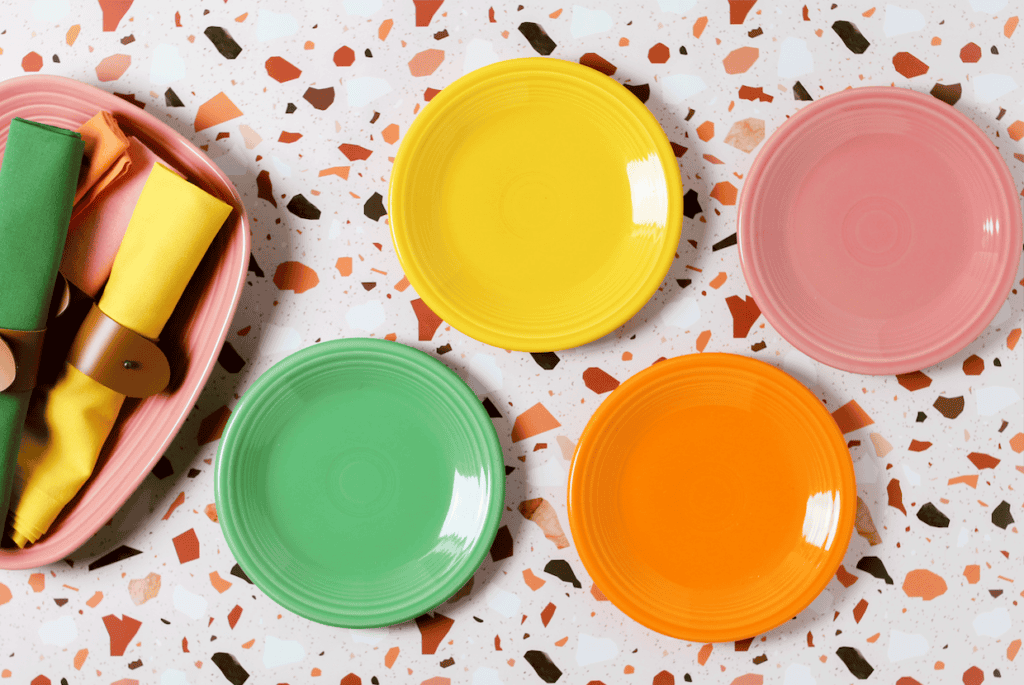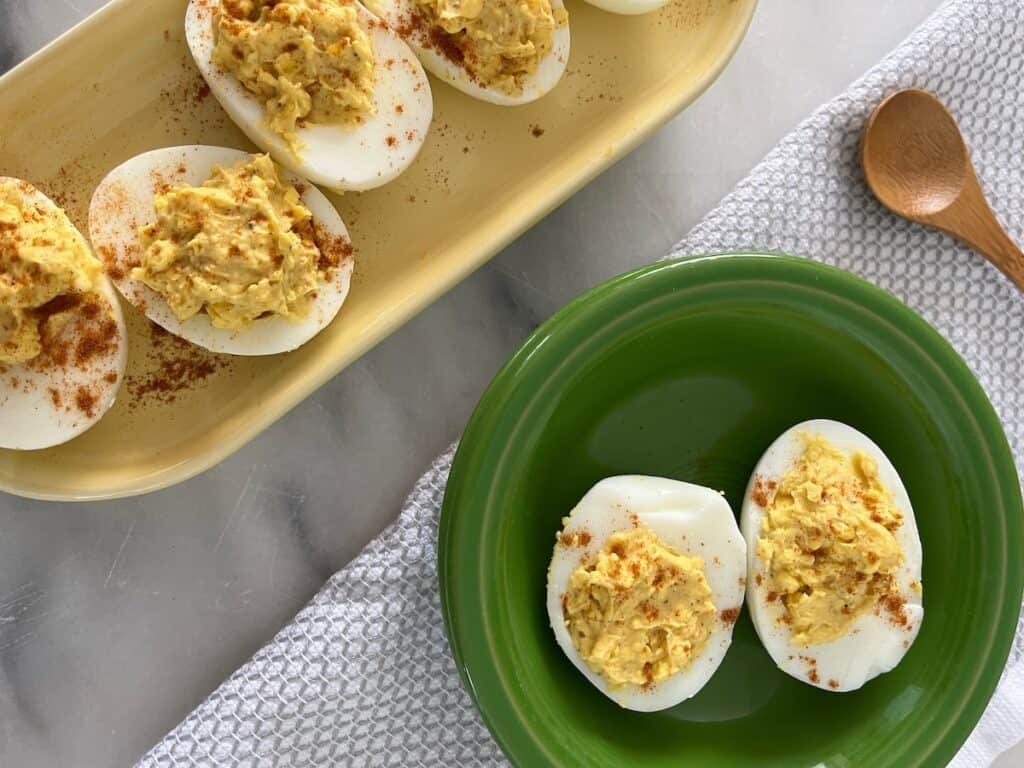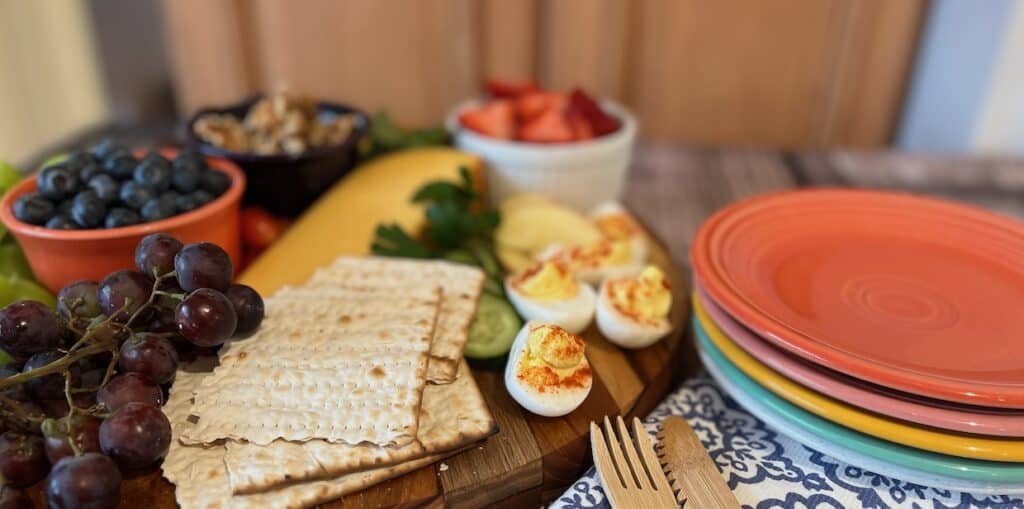If you like brightly colored dishes, then you probably love Fiestaware like I do. We’re in good company, too, since Fiestaware has been around since just before World War II. Read on to learn the history of the company and why these dishes make an everyday table look festive year-round.

Fiestaware is as American as apple pie
Homer Laughlin, Fiesta’s parent company, started making its art deco-inspired ceramic dishes in 1936. By some accounts, the creation of colorful Fiestaware was a way to help Americans feel a bit more cheerful after the Great Depression.
That very first collection started with just a handful of colors and pieces. However, in the next decade, Homer Laughlin ramped up production in their West Newell, West Virginia factory. Just down the Ohio River from Pittsburgh, some 120 million pieces were coming off the production line annually.
During the early years, Fiestaware — also known as Fiesta — enjoyed its fair share of notoriety. For example, according to the Museum of Radiation and Radioactivity, the company achieved some of the brightest Fiesta dish colors by using uranium in the glazes. No worries — that practice stopped in the 1970s, though those on the hunt for vintage Fiestaware should probably make a note of the production year before buying potentially radioactive dishes.
Also, like much of the paint used during the mid-20th century, the glazes were once lead-based. By 1986, they introduced five newly updated colors, all certified lead-free: white, black, cobalt, rose and apricot. Since then, all colors have also been free from lead.
A new color every year

One of the ways that Homer Laughlin has continued to keep Fiestaware relevant and cookware collectors wanting more is by creating limited edition colors. Or, they would produce certain colors for special occasions only. For instance, in 1986, they did a limited edition run exclusively for Bloomingdales in two colors: lilac and chartreuse.
Since 2000, the company has introduced at least one new color annually. The first color to roll off the production line was Cinnabar. It looks like a cross between cinnamon and burgundy. The company retired that color in 2010.
Fiestaware makes a great wedding anniversary gift for fans who love the brand. With a new color coming out each year, you could give the recipients a new piece in that year’s color. You can choose from platters, olive dishes and decorative pottery, like a flower vase.
You can also buy Fiestaware place settings to replace everyday dishes. These place settings come with a dinner plate, bread plate, bowl and teacup with a plate. They come in a variety of colors, including:
- Sunflower
- Shamrock
- Scarlet
- Turquoise
- Mulberry
- Marigold
Fiestaware continued to offer new colors even during the pandemic. The colors for 2020 and 2021 were Butterscotch and Twilight, respectively. Most recently, the 2023 color was Jade and for 2024 it was Sky, a pale blue.
Creating a colorful kitchen

If you like other vibrant kitchen appliances, then you’re going to love Fiesta’s colorful plates, dishes, bowls and cups. They’ll go well with KitchenAid Mixers, which come in a variety of hues, including cranberry, baby blue and mint green.
Other appliance companies offer similar options for color-coordinating your kitchen. If you’re upgrading to the high-end Ankarsrum mixer, your choice includes these seemingly Fiesta-inspired colors:
- Mango
- Tangerine
- Lemon yellow
- Cobalt blue
Just as you mix and match a capsule wardrobe to get the most use out of it, you may enjoy doing the same with Fiestaware. You can mix and match dinner plates, bread plates, salad bowls and coffee cups. That way, when you set the table for some company, you never set it the same way twice.
You may be surprised to learn that Fiestaware offers more than the aforementioned plates and serving pieces. For instance, you can buy Fiesta plates and accessories for your pets. Some are practical, while others are whimsical, such as a now-discontinued red ceramic cat treat jar with a handle shaped like a cat’s head.
Also, they have different shaped items. “I have red and white and purple star-shaped plates, which I set out for holiday snacks and cookies,” said Jennifer Osborn from Kitchen Serf. Osborn is such a Fiestaware fan that she added it to her wedding registry instead of traditional china.
Fiesta warranties and special features
Fiestaware pieces are made to last. And while the dishes and accessories don’t have a lifetime warranty, per se, they do have a five-year chip warranty. That is, if the dishes chip during the first five years of ownership, Homer Laughlin will replace it.
These pieces are as durable as Pyrex and Corningware are. Fiesta pieces are designed to go directly from the freezer to an oven as hot as 500 F. In addition, they are microwave and dishwasher safe.
Where to shop for Fiestaware
Because Fiestaware continues to put out new colors and lines annually, you won’t have a hard time finding pieces. Regular department and big box stores like Macy’s, Kohl’s and Dillard’s sell these dish sets and serving accessories.
There are three factory outlet stores — two in West Virginia and one in Ohio. Also, there is an official Fiesta Factory Direct online store. The one place you shouldn’t buy Fiestaware pieces? Amazon. It doesn’t appear there is an official Homer Laughlin store on the platform, so you can’t know for sure whether what you buy on Amazon is legitimate or official Fiesta.
If you decide to buy used Fiestaware at Goodwill, a thrift store or a yard sale, you should look for a stamp on the back or bottom that shows it is authentic. In most instances, this stamp is built right into the mold that makes the pieces, so you’ll see it imprinted. However, if you find a piece made before 1973, it might not have a stamp on the bottom at all. Also, as mentioned earlier, it could be radioactive.
Final thoughts
If you’re looking to make your kitchen table, dining room or kitchen more colorful and festive, then you’ll love Fiestaware. You’ll surely enjoy adding to your Fiesta collection annually with that year’s new color.
Leah Ingram likes to use her Fiestaware pieces when photographing recipes on her food blog Bagels and Lasagna.